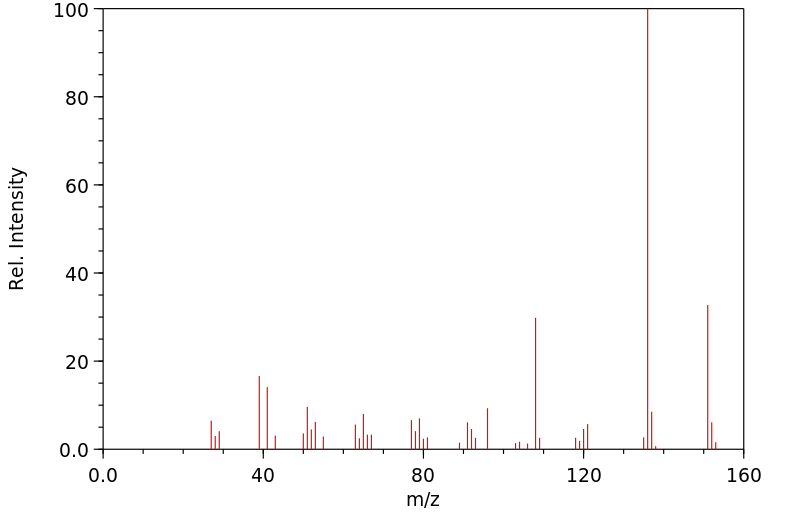4-叔-丁基吡啶 1-氧化 | 23569-17-7
中文名称
4-叔-丁基吡啶 1-氧化
中文别名
4-叔-丁基吡啶1-氧化;4-叔丁基吡啶1-氧化物
英文名称
4-tert-butylpyridine N-oxide
英文别名
4-(tert-butyl)pyridine 1-oxide;4-t-butylpyridine-N-oxide;4-tert-butyl-1-oxypyridine;4-tert-Butylpyridine 1-oxide;4-tert-butyl-1-oxidopyridin-1-ium
CAS
23569-17-7
化学式
C9H13NO
mdl
MFCD00082431
分子量
151.208
InChiKey
CMFQXPIZAKBRCG-UHFFFAOYSA-N
BEILSTEIN
——
EINECS
——
-
物化性质
-
计算性质
-
ADMET
-
安全信息
-
SDS
-
制备方法与用途
-
上下游信息
-
文献信息
-
表征谱图
-
同类化合物
-
相关功能分类
-
相关结构分类
物化性质
-
熔点:103.9-104.3 °C
-
沸点:286.6±9.0 °C(Predicted)
-
密度:0.94±0.1 g/cm3(Predicted)
计算性质
-
辛醇/水分配系数(LogP):1.5
-
重原子数:11
-
可旋转键数:1
-
环数:1.0
-
sp3杂化的碳原子比例:0.444
-
拓扑面积:25.5
-
氢给体数:0
-
氢受体数:1
安全信息
-
海关编码:2933399090
-
危险性防范说明:P264,P280,P302+P352,P337+P313,P305+P351+P338,P362+P364,P332+P313
-
危险性描述:H315,H319
-
储存条件:存储在室温下,保持在惰性气体中。
SDS
上下游信息
反应信息
-
作为反应物:描述:4-叔-丁基吡啶 1-氧化 在 亚磷酸三苯酯 、 盐酸 、 硫酸二甲酯 作用下, 以 吡啶 为溶剂, 反应 35.0h, 生成 N,N'-(4,5-dichloro-o-phenylene)bis(4-tert-butylpyridine-2-carboxamide)参考文献:名称:Synthesis, crystal structure and catalytic activities of [RuIII(bbpc)(PPh3)Cl][H2bbpc = 1,2-bis(4-tert-butylpyridine-2-carboxamido)-4,5-dichlorobenzene]摘要:The compound H(2)bbpc [1,2-bis(4-tert-butylpyridine-2-carboxamido)-4,5-dichlorobenzene], which has good solubility in organic solvents, has been prepared. Reaction of [Ru(PPh(3))(3)Cl-2] with H(2)bbpc in ethanol and in the presence of triethylamine gave [Ru-II(bbpc)(PPh(3))Cl], the crystal structure of which has been determined. This complex is an active catalyst for alkene epoxidation by PhlO, cyclopropanation of styrene by ethyl diazoacetate and aziridination of styrene by PhlNO(2)SC(6)H(4)Me-p. Its cyclic voltammogram in dichloromethane showed a reversible Ru-III-Ru-II couple at -0.55 V and an oxidation couple at 0.32 V.DOI:10.1039/dt9950002215
-
作为产物:描述:参考文献:名称:臭氧介导的胺氧化及其他:一种无溶剂流动化学方法摘要:臭氧是一种强氧化剂,最常用于将烯烃氧化成羰基化合物。其他臭氧介导的反应的合成效用因其高反应性和过度氧化有机分子(包括大多数溶剂)的倾向而受到阻碍。通过将基质和臭氧吸附到硅胶上,提供一种无溶剂氧化方法,可以在很大程度上缓解这一挑战。在这份手稿中,描述了一种基于流动的填充床反应器方法,它提供了对反应温度和时间的特殊控制,以实现对这一具有挑战性的转化的改进控制和化学选择性。实现了将伯胺氧化成硝基烷烃的有效方法。还展示了吡啶、C-H 键和芳烃氧化的例子,证实该系统可推广到各种臭氧介导的过程。DOI:10.1021/acs.joc.1c00768
文献信息
-
Synthesis of Unsymmetrically Substituted Bipyridines by Palladium-Catalyzed Direct C−H Arylation of Pyridine <i>N</i>-Oxides作者:Sasa Duric、C. Christoph TzschuckeDOI:10.1021/ol200565u日期:2011.5.6Substituted bipyridines were efficiently prepared by direct coupling between pyridine N-oxides and halopyridines using a palladium catalyst. Pyridine N-oxides with electron-withdrawing substitutents gave the best yields. This method allows the convenient preparation of 2,2′-, 2,3′-, and 2,4′-bipyridines which are useful as functionalized ligands for metal complexes or as building blocks for supramolecular
-
Radical Trifluoromethoxylation of Arenes Triggered by a Visible‐Light‐Mediated N−O Bond Redox Fragmentation作者:Benson J. Jelier、Pascal F. Tripet、Ewa Pietrasiak、Ivan Franzoni、Gunnar Jeschke、Antonio TogniDOI:10.1002/anie.201806296日期:2018.10.15method enables non‐directed functionalization of C−H bonds on a range of substrates, providing access to aryl trifluoromethyl ethers. This light‐driven process is distinctly different from conventional procedures and occurs through an OCF3 radical mechanism mediated by a photoredox catalyst, which triggers an N−O bond fragmentation. The pyridinium‐based trifluoromethoxylation reagent is bench‐stable and
-
Deoxygenation of pyridine<i>N</i>-oxides with dimethylthiocarbamoyl chloride
-
Clean protocol for deoxygenation of epoxides to alkenes <i>via</i> catalytic hydrogenation using gold作者:Jhonatan L. Fiorio、Liane M. RossiDOI:10.1039/d0cy01695k日期:——The epoxidation of olefin as a strategy to protect carbon–carbon double bonds is a well-known procedure in organic synthesis, however the reverse reaction, deprotection/deoxygenation of epoxides is much less developed, despite its potential utility for the synthesis of substituted olefins. Here, we disclose a clean protocol for the selective deprotection of epoxides, by combining commercially available烯烃的环氧化是保护碳-碳双键的一种策略,是有机合成中众所周知的方法,然而,尽管逆反应,环氧化物的脱保护/脱氧反应却很少开发,尽管它可以用于合成取代的烯烃。在这里,我们通过结合市售的有机磷配体和金纳米颗粒(Au NP)公开了一种用于环氧化物选择性脱保护的清洁方法。除了成功地用于环氧化物的脱氧中,发现的催化体系还能够使用分子氢作为还原剂选择性还原N-氧化物和亚砜。金NP催化剂与亚磷酸三乙酯P(OEt)3结合与仅金纳米颗粒相比,它的反应性明显更高。该方法不仅是在温和条件下的互补的Au催化还原反应,而且是一种选择性还原各种有价值的分子的有效方法,这些分子在合成上不方便,或者通过替代合成方案或使用经典方法难以获得,过渡金属催化剂。
-
Heteroleptic Ir(III) phosphors with bis-tridentate chelating architecture for high efficiency OLEDs申请人:NATIONAL TSING HUA UNIVERSITY公开号:US09219237B1公开(公告)日:2015-12-22A bis-tridentate iridium complex represented by a formula (I): where R3 to R8, R21 to R23, R9, R10, X1, X2, and X3 are as defined in the specification.一个由公式(I)表示的双三齿钌配合物: 其中R3至R8、R21至R23、R9、R10、X1、X2和X3的定义如说明书所述。
表征谱图
-
氢谱1HNMR
-
质谱MS
-
碳谱13CNMR
-
红外IR
-
拉曼Raman
-
峰位数据
-
峰位匹配
-
表征信息
同类化合物
(S)-氨氯地平-d4
(R,S)-可替宁N-氧化物-甲基-d3
(R)-(+)-2,2'',6,6''-四甲氧基-4,4''-双(二苯基膦基)-3,3''-联吡啶(1,5-环辛二烯)铑(I)四氟硼酸盐
(R)-N'-亚硝基尼古丁
(R)-DRF053二盐酸盐
(5E)-5-[(2,5-二甲基-1-吡啶-3-基-吡咯-3-基)亚甲基]-2-亚磺酰基-1,3-噻唑烷-4-酮
(5-溴-3-吡啶基)[4-(1-吡咯烷基)-1-哌啶基]甲酮
(5-氨基-6-氰基-7-甲基[1,2]噻唑并[4,5-b]吡啶-3-甲酰胺)
(2S,2'S)-(-)-[N,N'-双(2-吡啶基甲基]-2,2'-联吡咯烷双(乙腈)铁(II)六氟锑酸盐
(2S)-2-[[[9-丙-2-基-6-[(4-吡啶-2-基苯基)甲基氨基]嘌呤-2-基]氨基]丁-1-醇
(2R,2''R)-(+)-[N,N''-双(2-吡啶基甲基)]-2,2''-联吡咯烷四盐酸盐
(1'R,2'S)-尼古丁1,1'-Di-N-氧化物
黄色素-37
麦斯明-D4
麦司明
麝香吡啶
鲁非罗尼
鲁卡他胺
高氯酸N-甲基甲基吡啶正离子
高氯酸,吡啶
高奎宁酸
马来酸溴苯那敏
马来酸氯苯那敏-D6
马来酸左氨氯地平
顺式-双(异硫氰基)(2,2'-联吡啶基-4,4'-二羧基)(4,4'-二-壬基-2'-联吡啶基)钌(II)
顺式-二氯二(4-氯吡啶)铂
顺式-二(2,2'-联吡啶)二氯铬氯化物
顺式-1-(4-甲氧基苄基)-3-羟基-5-(3-吡啶)-2-吡咯烷酮
顺-双(2,2-二吡啶)二氯化钌(II) 水合物
顺-双(2,2'-二吡啶基)二氯化钌(II)二水合物
顺-二氯二(吡啶)铂(II)
顺-二(2,2'-联吡啶)二氯化钌(II)二水合物
韦德伊斯试剂
非那吡啶
非洛地平杂质C
非洛地平
非戈替尼
非布索坦杂质66
非尼拉朵
非尼拉敏
雷索替丁
阿雷地平
阿瑞洛莫
阿扎那韦中间体
阿培利司N-6
阿伐曲波帕杂质40
间硝苯地平
间-硝苯地平
镉,二碘四(4-甲基吡啶)-
锌,二溴二[4-吡啶羧硫代酸(2-吡啶基亚甲基)酰肼]-







